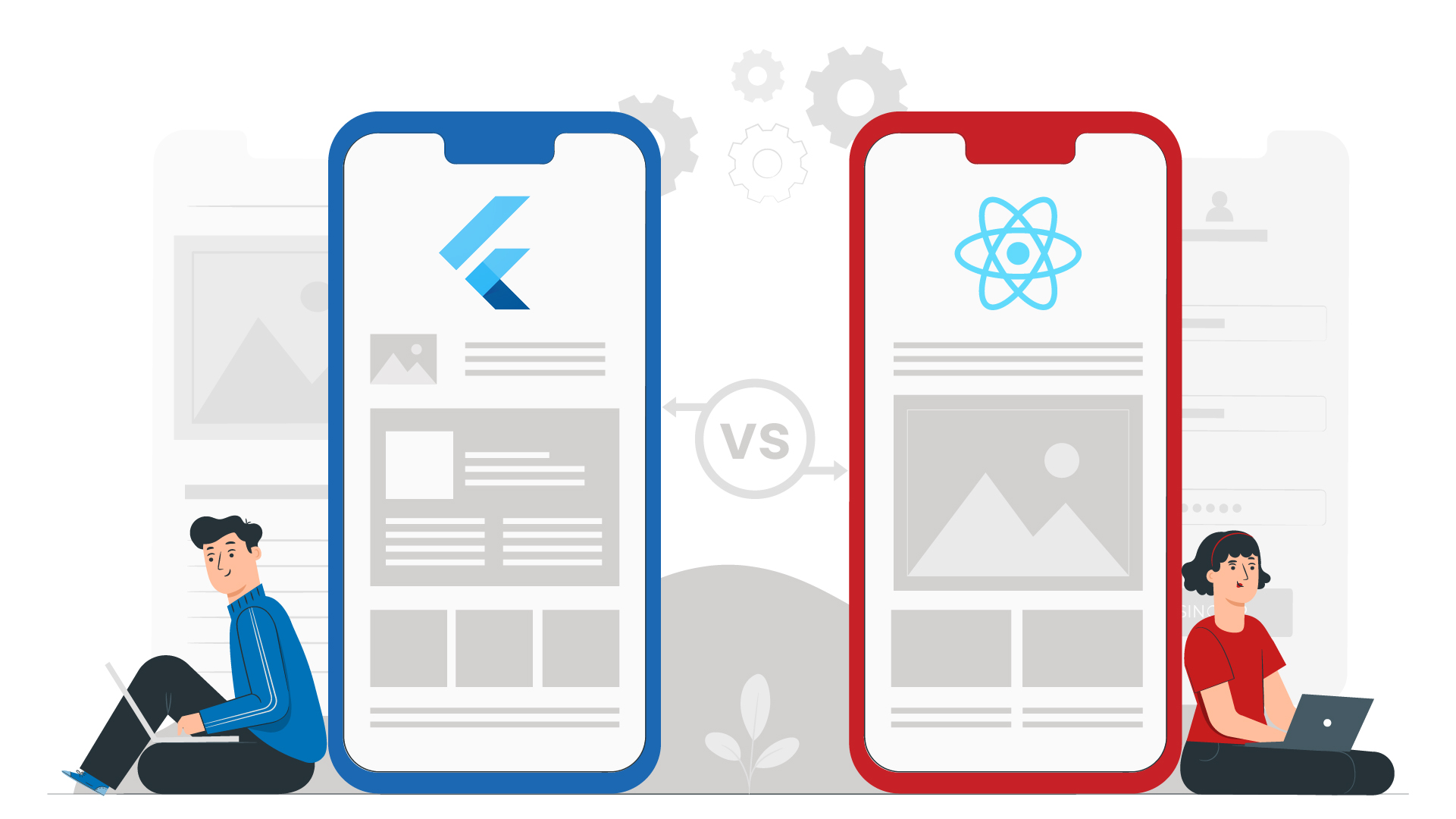
Flutter vs React Native For App Development — What Should You Use?
Jerry Wallis
9 min read

There’s no denying that Flutter and React Native are two of the most popular mobile development frameworks out there.
So which one should you choose? Let’s take a look at Flutter vs React Native to see what they have to offer.
Cross-Platform Mobile Development Framework 🧐
A cross-platform mobile development framework is a tool that allows developers to create apps for multiple mobile platforms with a single codebase. This can be a great way to save time and resources when developing mobile apps, as it eliminates the need to create separate codebases for each platform.
Several different cross-platform mobile development frameworks are available, each with advantages and disadvantages. Some popular frameworks include React Native, Flutter, Ionic, and Xamarin.

When choosing a cross-platform mobile development framework, you must consider your app’s specific needs and which platform you’re targeting. For example, if you’re looking to create a cross-platform app with a native look and feel, you’ll want to choose a framework like React Native or Ionic. However, if you’re targeting a Windows phone (which is quite rare!), you’ll want to use a framework like Xamarin.
Remember that mobile applications were traditionally written in native languages with Java or Swift. However, with the need for hybrid apps that work on multiple devices, mobile applications are being written in cross-platform languages such as React Native or Flutter. Even with hybrid apps, you can still manage to provide a native app-like look, feel, and performance.
Ultimately, the best cross-platform mobile development framework for your needs will depend on various factors. Be sure to do your research and choose the framework that’s right for you.
This article will explain why React Native and Flutter are two of the most commonly used frameworks for mobile development — and which one you should choose for your next project. Keep reading to learn more about Flutter vs React Native.
What’s Flutter? 🦋
Flutter is a mobile app software development kit (SDK) for building high-quality native interfaces on iOS and Android. Flutter is a relatively newer framework released by Google in 2017. It uses the Dart programming language, which is also developed by Google.

One key advantage of Flutter is its speed; because it doesn’t rely on platform-specific UI components, it can render UI much faster than React Native. That’s because Flutter is reactive, meaning that changes to the UI are reflected in the app immediately, without needing to recompile every time. Another advantage is its flexibility; with Flutter, you can create custom UI designs that aren’t possible with React Native.
Likewise, Flutter’s programming language, Dart, is easy to learn and use for developers coming from other complex languages. Besides, Flutter uses the Skia graphics library, giving its apps a polished and professional look. Also, Flutter apps are fast because they are compiled ahead of time to native code.
Apps such as Google Ads, Reflect, Abbey Post, etc., have been created using the Flutter app framework. More and more companies are relying on Flutter to develop cross-platform apps that are customisable, scalable, and future-proof. To learn more about Flutter, check out our comprehensive article that explains the ins and outs of Flutter app development.
Key Features of Flutter 🔑
- Hot Reload: This allows you to change your code and see the results immediately without restarting your app or recompiling the code. This makes Flutter productive and efficient.
- Widget Library: Flutter contains an extensive collection of pre-built widgets that can be used to create sophisticated user interfaces. Besides, these widgets are highly customisable, so it’s easy for developers to create custom user interfaces that can be tailored to specific business needs.
- Dart Language: Flutter is written in an easy-to-learn programming language that is compiled to native code. That’s why you can create high-performance apps that run smoothly on all devices with Flutter.
- Single Codebase: Since Flutter apps can be compiled for both iOS and Android devices from a single codebase, you don’t have to maintain two separate codebases. This saves a lot of time and effort.
- Futter For Desktop Apps: In addition to creating mobile apps, you can also build desktop applications with Flutter. Though the desktop version is still in the early stages of development, you can make working or minimally viable apps.
Downsides of Flutter 👎
While it has many advantages, there are also some downsides to using Flutter. One downside of Flutter is that it can be more difficult to debug than natively built apps. This is because Flutter uses a different set of widgets than the native iOS and Android SDKs. As a result, you may need to use a different set of tools to debug your Flutter app. Additionally, Flutter apps can be larger in size than their native counterparts.
Another potential downside of Flutter is that it may not be as well suited for complex apps. This is because Flutter uses a single codebase for iOS and Android, making it more difficult to manage different platform-specific features. Additionally, Flutter’s hot reload feature can sometimes cause issues with complex app states.
What’s React Native? 🔨
React Native, on the other hand, was released by Facebook in 2015. It uses the JavaScript programming language, one of the most popular languages among developers.

React Native is a popular framework for developing mobile apps. It is based on React, a JavaScript library for building user interfaces. React Native lets you create native apps for Android and iOS using React.
The best thing about React Native is that it has many advantages over traditional native development frameworks. React Native uses the same fundamental UI building blocks as regular iOS and Android apps. This makes it easy to create a React Native app that feels native to both platforms.
What’s more, React Native also has a large community of developers and many resources available. This makes it easy to find help when you need it.
Apps such as Facebook, Instagram, Skype, etc., have been created by using React Native. As the older mobile development framework, there are hundreds of thousands of apps currently benefit from using React Native’s platform.
React Native is an excellent choice for developing cross-platform mobile apps. It has all the benefits of React and lets you create native apps for Android and iOS. If you’re looking for a framework that will allow you to develop high-quality mobile apps quickly, React Native is worth considering.
Key Features of React Native 🗝️
- Live Reload: This allows you to make changes to your code and see the results immediately without restarting your app.
- Declarative Programming Style: The declarative programming style makes code snippets more readable and understandable. Developers can then create complex interfaces in an easy-to-read coding environment.
- Component-Based Architecture: This makes it easy to create reusable UI components that can be composed to create complex user interfaces. This also saves time and effort while developing apps.
- JavaScript Language: JavaScript is the most popular programming language in the world, which React Native also uses. This makes it easy for developers to code, as many of them are already familiar (if not well-versed) with JavaScript.
- React Native For Desktop: React Native is also used to create desktop applications, as the open-source code allows developers to create native apps with JavaScript. The apps are responsive, easy to use, and elegant.
Downsides of React Native 👎
React Native is a popular framework for developing mobile apps. However, developers should be aware of some downsides to using React Native. One downside of React Native is that it can be tricky to debug. React Native apps are compiled down to native code, so it can be challenging to figure out what the problem is when something goes wrong.
Another downside of React Native is that it doesn’t have as many customisable features as some other frameworks. React Native doesn’t have all the bells and whistles that some older frameworks do. This can be a problem if you need specific features for your app. You will be forced to build such custom modules from scratch.
Also, React Native can be slow and complicated to update. React Native apps depend on the React Native framework, which can take a while to roll out new updates. This can be a problem if you need to use new features or bug fixes as soon as they’re available.
Though React Native is a great framework, it has some limitations. Keep these in mind when deciding whether or not React Native is the proper framework for your project.
So Which Framework Should You Use On Your Project? 💭
There are several factors to consider, such as the type of app you want to create, your development experience, and your team’s skills.
If you want to create a simple app with a few screens, then either framework will work well. However, if you’re looking to create a more complex app with many features, you may want to choose React Native. This is because React Native has a more mature codebase and a large community of developers who can help you.
Additionally, if you’re experienced with web development using JavaScript, you’ll likely find React Native easier to learn. On the other hand, if you’re new to mobile development, Flutter may be a better choice. This is because Dart is a more straightforward language to learn for beginners.
Finally, it’s essential to consider the skills of your team. If you have a group of experienced mobile developers, they may be more familiar with React Native and its ecosystem. However, if you have a team of web developers, they may find it easier to learn Flutter.
In Conclusion 📋
Not sure which mobile development platform to use for your next project? After all, there is no right or wrong answer when choosing between Flutter and React Native. It depends on your specific business needs and development requirements.
Flutter and React Native are both popular choices, but it can be tough to decide which one is right for you. If you’re not sure where to start, our team can help. We have experience with both Flutter and React Native, and we can help you choose the right platform for your project.
Write to us for a friendly discovery chat. We will be able to assess your project requirements and suggest the best framework for your needs.
Topics
Published On
July 14, 2022

